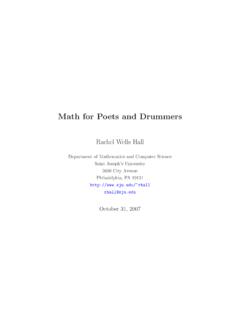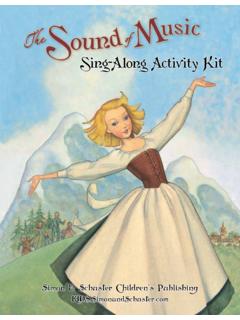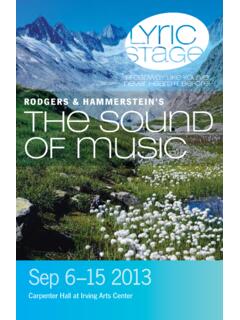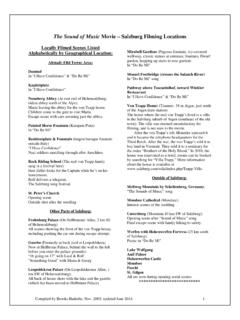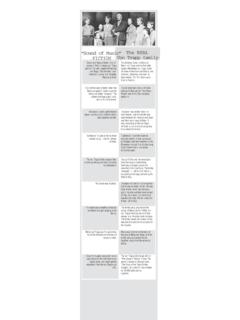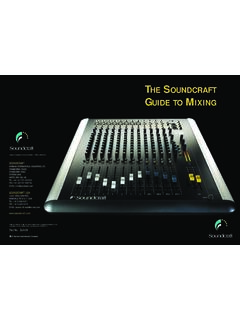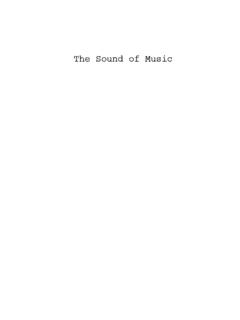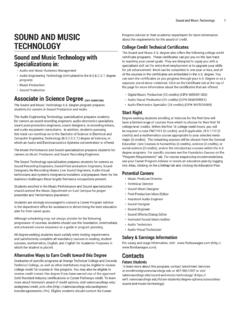Transcription of The Sound of Numbers - Saint Joseph's University
1 The Sound of NumbersA Tour of Mathematical music TheoryRachel Wells HallDepartment of Mathematics and Computer ScienceSaint Joseph s University5600 City AvenuePhiladelphia, PA 31, 2008 ContentsPrefaceiiAbstract.. iiIntroduction.. iiDetails.. iiiChapter-by-chapter summaries.. viiiAbout the author.. xviiIntroduction11 Math for Poets and Drummers7 Pingala and the binary representation of meter.. 8 Pascal s Triangle and the Expanding Mountain of Jewels.. 15 The Hemachandra-Fibonacci Numbers .. 17 Naming rhythms.. 20 Bibliography25 Author s CV30iPrefaceAbstractThe Sound of Numbersis a book on the mathematics of music theory that is, the use ofmathematics to describe, analyze, and create musical structures such as rhythms, scales,chords, and melodies. music theorists have used mathematics to solve musical problems forcenturies. Mathematicians, too, have investigated musical questions. Some composers haveturned to mathematics for inspiration.
2 However, there has been a significant disconnectbetween these two fields since the eighteenth century. This book aims to interpret the workof music theorists in a manner that is accessible to readers with scientific training and somebackground in music , and it aims to explain how problems in music theory are connectedto problems that arise in are a surprising number of applications of mathematics to music theory. Questionsabout variation, similarity, enumeration, and classificationof musical structures have longintrigued both musicians and mathematicians. In some cases, theseproblems inspiredmathematical discoveries. In ancient India, for example, investigation of rhythm led to thediscovery of the Fibonacci Numbers and Pascal s triangle. Pages from Euler s notebooksreveal that he experimented with tuning systems and rhythmic variation. Although thisbook does not describe groundbreaking mathematical results, it nonetheless containsproblems that are appealing, nontrivial, and, in some cases, connected to deepmathematical Sound of Numberscovers topics that are interesting from both a mathematical andmusical standpoint.
3 These include techniques discovered in ancient India for counting andiiPREFACE iiicreating variations on poetic rhythms; the role of acoustics in harmonic consonance; theconstruction of musical scales, both familiar and exotic; mathematical models for rhythmand meter; the group theory of chords; geometrical models forcounterpoint; and distancemeasures in music . Many of these topics are the subject of currentresearch. Some areconnected to open mathematical questions. Others have inspired composers to create books on mathematics and music aimed at a scientific audience have appearedrecently. I mean to supplement these works, rather than repeat material availableelsewhere. My criteria for the inclusion of a topic in this bookare that it has validitywithin the field of music theory and is mathematically audienceThis book is written for a reader with a scientific background and some training inmusic a reader who is comfortable with a degree of abstractionand who has anintellectual curiosity about mathematics and music .
4 AlthoughI assume familiarity withcommon mathematical notation, I will define terms that are specific to mathematics (thatis, those that appear beyond the undergraduate calculus sequence). For example, I usevariables and summation notation in Chapter1without introduction; however, inChapter5I mean to define a mathematical group. Although calculus itselfis not necessaryto understand most of the material, the typical reader will have taken at least a year ofcalculus and have basic musical training, including the rudiments of music theory andnotation. However, the background required varies from chapter to chapter. For example,Chapter1is accessible to a high school math student, and does not require any , music theorists, and composers with some mathematical training are asecondary audience for the book. Moreover, although the bookis not intended as atextbook, I use some of the topics described in the book in a courseon mathematics andmusic that I styleI believe that mathematics should be presented in the most direct way possible.
5 Wherethere are choices of methods, I prefer those that do not requirespecialized knowledge. Thetechniques used in this book come from the fields of combinatorics, differential equations, number theory, discrete mathematics, group theory, geometry, and probability. I intend thebook to be largely self-contained. I will explain, rather than invoke, results that areneeded. For example, in Chapter5I will give a short proof of Burnside s , for the most part, I mean to avoid the straight theorem-proof style ofmathematical exposition, I will state some theorems (Chapter1is atypical in this respect).I intend to provide proofs if they are relatively short and accessible. Where proofs are moretechnical, I will give the gist of the argument and refer the reader to the original are points of intersection between the topics in this book and more specializedmathematics. Some of my readers will be professional mathematicians who appreciate theseconnections.
6 For example, tiling canons and theZ-relationship discussed in Chapter6arerelated to the factorization of polynomials. I intend to mention advanced topics at the endof a section. Readers who are not familiar with the subject may skip to the next will the reader gain from this book?For most readers, this will be a recreational mathematics book. However, the subject ofmath and music has surprising depth. I hope that the reader of this book will come toappreciate some of the multiple ways that mathematics is used to describe, analyze, andcreate music ; be intrigued by the process of abstracting mathematical structure from musictheoretical definitions; be inspired to make further investigations into the mathematics ofmusic; and experiment with using mathematics to create music . Ultimately, my goal is thatthe reader gains a better understanding of both math and featuresSeveral books on mathematics and music aimed at a scientific audience have appearedrecently.
7 However, this book fills a need not met by any other for two , the work of music theorists deserves to be better known to scientists. Many scientificwriters have treated acoustics, Sound recording, and Sound synthesis; some have givencursory treatment to music theory ( [5]). No writer has yet written in depth aboutPREFACE vmathematical research done both by music theorists and mathematicians that is inspiredby music theory. This field is growing quickly. Much of the research I describe has beendone in the past ten years; some is connected to open mathematical , music theory is coming into its own as a field of appliedmathematics and wouldbenefit from a book that connects it to mainstream science. In the past, music theoristshave worked on problems in isolation and, as a result, often reproved well-knownmathematical results or labored too long over problems that were genuinely difficult. Thefact that similar techniques arise in other applied mathematical fields (computationalgeometry, crystallography, physics, economics, and statistics) offers them a rich backgroundon which to draw.
8 In addition, several scientists ( Sethares [52], Toussaint [15]) havedone groundbreaking work in music that has escaped the attention of many music I have classical training, my primary background is intraditional folk music , andthis gives me a somewhat unusual perspective. I intend to draw upon examples from jazz,popular, and traditional music as well as from Western isnotin this book?I deliberately avoid several topics. This is not a book on music perception, performanceanalysis, or the styles of particular composers. I will give briefattention to acoustics,tuning systems, and Sound synthesis and recording, as these are exhaustively covered byother authors (see Benson [5], for example).My book is a comprehensive introduction to mathematical musictheory as practiced inNorth America. The only significant topic in mathematical music theory that I intend toomit is musical topos theory, an application of category theory to music represented in thework of Mazzola [37] and chiefly developed and practiced in Europe.
9 I do not believe themusical payoff to be large enough to warrant introduction ofsuch heavy-duty booksSeveral books on mathematics and music have appeared recently:1. Dave : A Mathematical Offering. Cambridge University Press,Cambridge, Leon Math behind the music . MAA Outlooks. CambridgeUniversity Press, Cambridge, John Fauvel, Raymond Flood, and Robin Wilson, and Mathematics:From Pythagoras to Fractals. Oxford University Press, Oxford, Gerard Assayag, Hans Georg Feichtinger, and Jose Francisco Rodrigues, and music . Springer-Verlag, Berlin, Gareth : The Mathematical Foundations of music . Vols. 1 and Press, 2006 s and Harkleroad s books aim to be comprehensive introductions to mathematicsand music . Their focus differs from mine in that they discuss acoustics, tuning systems,and electronic music more thoroughly than I intend, reference scientific and mathematicalliterature more than they reference the work of music theorists, have few references topopular or non-Western music , and almost completely ignore rhythm.
10 The third and fourthbooks are collections of essays on mathematics and music by different authors; they do notaim to be comprehensive treatments of mathematics and music . Loy s book is written formusicians rather than my intention is to supplement these books, rather than to compete with them, thereare only a few areas of overlap. Almost every book on math and music covers acoustics andtuning systems; my treatment will be relatively brief, as I primarily use these topics tomotivate scale theory. Benson covers symmetry in music in one chapter (the remainingeight cover acoustics, tuning systems, and digital sampling and synthesis). This chapteroverlaps with my discussion of transformations (Chapter5); however, I intend to go intomore depth. Chemillier s article on African drumming [10] in the Springer book inspiredKlingsberg s and my research on asymmetric rhythms discussed in of the original research described in this book representswork that I have done withcoauthors.
